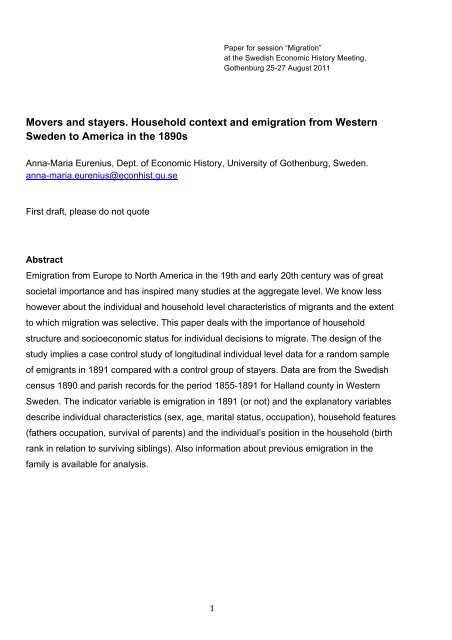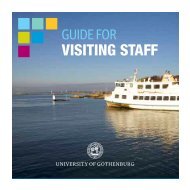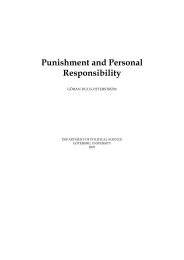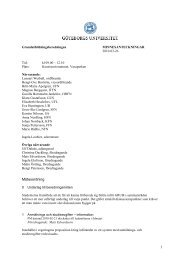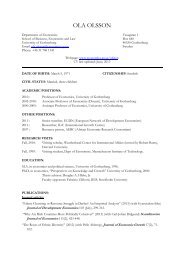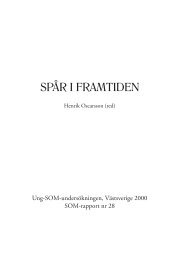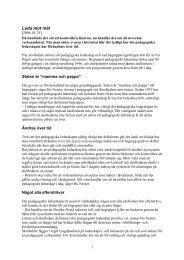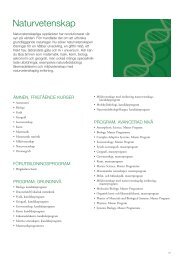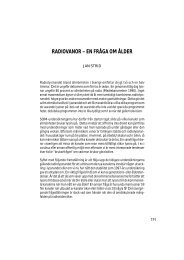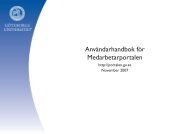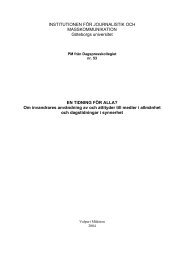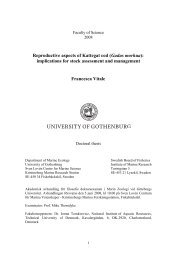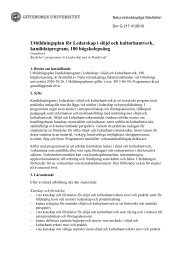Movers and stayers. Household context and emigration from ...
Movers and stayers. Household context and emigration from ...
Movers and stayers. Household context and emigration from ...
You also want an ePaper? Increase the reach of your titles
YUMPU automatically turns print PDFs into web optimized ePapers that Google loves.
Paper for session “Migration”<br />
at the Swedish Economic History Meeting,<br />
Gothenburg 25-27 August 2011<br />
<strong>Movers</strong> <strong>and</strong> <strong>stayers</strong>. <strong>Household</strong> <strong>context</strong> <strong>and</strong> <strong>emigration</strong> <strong>from</strong> Western<br />
Sweden to America in the 1890s<br />
Anna-Maria Eurenius, Dept. of Economic History, University of Gothenburg, Sweden.<br />
anna-maria.eurenius@econhist.gu.se<br />
First draft, please do not quote<br />
Abstract<br />
Emigration <strong>from</strong> Europe to North America in the 19th <strong>and</strong> early 20th century was of great<br />
societal importance <strong>and</strong> has inspired many studies at the aggregate level. We know less<br />
however about the individual <strong>and</strong> household level characteristics of migrants <strong>and</strong> the extent<br />
to which migration was selective. This paper deals with the importance of household<br />
structure <strong>and</strong> socioeconomic status for individual decisions to migrate. The design of the<br />
study implies a case control study of longitudinal individual level data for a r<strong>and</strong>om sample<br />
of emigrants in 1891 compared with a control group of <strong>stayers</strong>. Data are <strong>from</strong> the Swedish<br />
census 1890 <strong>and</strong> parish records for the period 1855-1891 for Hall<strong>and</strong> county in Western<br />
Sweden. The indicator variable is <strong>emigration</strong> in 1891 (or not) <strong>and</strong> the explanatory variables<br />
describe individual characteristics (sex, age, marital status, occupation), household features<br />
(fathers occupation, survival of parents) <strong>and</strong> the individual’s position in the household (birth<br />
rank in relation to surviving siblings). Also information about previous <strong>emigration</strong> in the<br />
family is available for analysis.<br />
<br />
1
1. Introduction<br />
Establishing the determinants of out-migration, i.e. what makes individuals leaving one<br />
place of residence for another, has for long been one of the major themes in migration<br />
studies. From an economic theory point of view the decision whether to move or not is a<br />
rational choice of the best option when the benefits (e.g. higher earnings) <strong>and</strong> costs (e.g.<br />
moving costs or psychic costs) of a migratory move have been calculated <strong>and</strong> compared. If<br />
the net gain <strong>from</strong> migration is positive, the individual decides to move; if it is negative, the<br />
decision is to stay. In this way, migration is an investment in higher net earnings in the<br />
future. Factors influencing the decision to move in this str<strong>and</strong> of literature are sex, age,<br />
marital status, human capital, earnings <strong>and</strong> employment (Sjaastad, 1962; Todaro 1969). For<br />
younger persons not only the own employment <strong>and</strong> earnings could be assumed to be<br />
important, also the possible support <strong>from</strong> the parental household <strong>and</strong> the competition over<br />
family resources with siblings could be assumed to count. Theory of chain migration predicts<br />
that the tendency to migrate is influenced by previous cohorts of migrants <strong>from</strong> the family or<br />
location (Carlsson, 1976).<br />
Although theory on migration determinants is basically at the micro level, studies of<br />
oversees migration in the 19 th century typically deals with macro data (Bohlin <strong>and</strong> Eurenius,<br />
2010; Hatton <strong>and</strong> Williamson, 1993, 1998). The reason for this is simply lack of individual<br />
level data. Emigration was a rare event, even in the 19 th century. At the most 1 % of the<br />
population moved during a year, usually substantially fewer. Calculating based on individual<br />
level data the importance of possible determinants of a rare outcome requires a large risk<br />
population. Modern Swedish register data allows such calculations since they could be<br />
made for the entire population or regional parts of it. For the period before the 1970s such<br />
data is not available though, <strong>and</strong> historians have to use databases of local populations of<br />
much smaller size, which makes it difficult to study the determinants of <strong>emigration</strong>.<br />
This study takes another approach, <strong>and</strong> attaches to an epidemiological method used in<br />
medical studies of rare outcomes: the case-control design. It implies that a group of<br />
emigrants is compared with a control group of non-emigrants across a number of potential<br />
determinants. The methods requires that the two groups could be r<strong>and</strong>omly drawn <strong>from</strong> the<br />
populations of movers <strong>and</strong> <strong>stayers</strong>, which is possible using the census of 1890 <strong>and</strong> the<br />
migration register of 1891.<br />
<br />
2
2. Data<br />
2.1 Sources<br />
This study is performed on data <strong>from</strong> the county of Hall<strong>and</strong> in the southwest of Sweden,<br />
which was the county with highest <strong>emigration</strong> rates during the period 1880 – 1910. The<br />
yearly average <strong>emigration</strong> rate in Hall<strong>and</strong> was approximately 10 persons per thous<strong>and</strong><br />
inhabitants. The same rate for the whole nation during that period was just below 6 persons.<br />
The study is based on individual data, which makes it possible to analyze the impact of<br />
factors reflecting human capital, household structures <strong>and</strong> socioeconomic status had on the<br />
decision to migrate.<br />
The sources are the 1890 census <strong>and</strong> church records such as catechetical examination<br />
records <strong>and</strong> migration registers. In the catechetical examination records the household<br />
members were listed by the parish priest every year. The purpose was to examine the<br />
biblical knowledge <strong>and</strong> reading skills of those living in the household. The records included<br />
basic lists of all household members <strong>and</strong> their birth years <strong>and</strong> birth parishes. Information on<br />
changes in the household since the previous record such as births, deaths <strong>and</strong> migration<br />
were also noted in the records. The catechetical examination records contained information<br />
on migration both into <strong>and</strong> out <strong>from</strong> the parish, <strong>and</strong> also within the parish. The priest<br />
recorded, when, where to <strong>and</strong> <strong>from</strong> where someone moved. When a person moved into or<br />
out <strong>from</strong> the parish he or she had to take out a change of address-certificate. It was issued<br />
by the parish priest who also recorded all moves during the year in the migration register.<br />
One can assume a certain underestimation of the <strong>emigration</strong> rates in the registers since the<br />
priests not always could separate <strong>emigration</strong> <strong>and</strong> domestic migration. The 1884 Emigration<br />
Ordinance made the data more reliable. Emigrant agents were then prohibited to convey<br />
any travels abroad if they could not present proper migration certificates for all emigrants to<br />
the police authority.<br />
The source material has made it possible to collect the necessary information to get as<br />
complete picture as possible of the living conditions of every individual in this study <strong>from</strong><br />
birth until the year 1890.<br />
<br />
3
2.2 The study design <strong>and</strong> sample<br />
Even though Hall<strong>and</strong> showed the highest <strong>emigration</strong> rates in Sweden, the overall probability<br />
to emigrate still was very small. On average one percent of the population in Hall<strong>and</strong><br />
emigrated each year during 1880 - 1910, which means that the necessary size of a r<strong>and</strong>om<br />
sample reflecting the real circumstances would be far too extensive. A suitable method for<br />
this study is therefore to perform a case-control study. The purpose of such a study is to<br />
identify <strong>and</strong> evaluate factors that may have an impact on an event by comparing groups of<br />
individuals that will execute the event (the “cases”) with groups that will not execute the<br />
event (the ”controls”) but are otherwise similar. This method is often used in epidemiological<br />
studies where individuals who have, for example, a disease are compared with a group that<br />
don´t have the disease regarding earlier exposure to different factors.<br />
Thus, the design of this study is as follows:<br />
Event: Emigrate to North America 1891<br />
Study population:<br />
Men <strong>and</strong> women living in the countryside in the county of Hall<strong>and</strong>, born 1856 – 1876,<br />
amounted to 42 382 persons.<br />
Sample of movers (the “cases”):<br />
As a first step all emigrants <strong>from</strong> Hall<strong>and</strong> 1891 living in the countryside were identified. This<br />
was done by searching the migration registers for 1891 in every one of the 88 countryside<br />
parishes in Hall<strong>and</strong>. It proved to be 1 500 persons emigrating. Then, all emigrants born<br />
1856 – 1876, i.e. in ages 15-35, with North America as destination were sorted out <strong>and</strong><br />
summed up to 1 150 individuals. At last a r<strong>and</strong>om sample was conducted by extracting<br />
every tenth of that group, which finally resulted in 115 emigrants constituting the “cases” in<br />
the study.<br />
Sample of <strong>stayers</strong> (the “controls”): The group of controls was made as a r<strong>and</strong>om sample of<br />
200 individuals <strong>from</strong> the study population in the same birth cohorts as the sample of movers.<br />
To access all relevant persons the sample was based on the census 1890.<br />
<br />
4
The starting point for this study is 1890. The “cases” emigrated to North America in 1891<br />
while the “controls” did not. To determine what influenced the decision on whether to move<br />
or not a rather significant amount of information has been collected for every individual. This<br />
has been done starting with the census 1890 <strong>and</strong> then by extracting data <strong>from</strong> church<br />
records. The aim has been to track every individual back to their place of birth <strong>and</strong> the<br />
family of origin. Mobility among young people in the countryside was still large during the<br />
latter part of the 1800s <strong>and</strong> changing employments often also meant changing place of<br />
residence. This has sometimes made the tracing rather complicated. The number of<br />
observations in the study may seem rather limited in this first draft. This is due to the<br />
extensive time required to locate each individual <strong>and</strong> to excerpt all necessary data.<br />
2.3 The variables<br />
The independent variables in this study can be divided into two groups. The first group<br />
consists of variables that reflect the individual’s human capital. A general view within<br />
migration research is that young unmarried people with no l<strong>and</strong> of their own were the most<br />
anxious to emigrate. They were considered to have had more to gain <strong>from</strong> migration than<br />
other groups <strong>and</strong> less ties to the home country. The variables sex, age, marital status <strong>and</strong><br />
the individual´s own profession represent this.<br />
The other group of variables reflects household structure <strong>and</strong> socioeconomic status. The<br />
assumption here is that the propensity to emigrate was dependent on the parents’ social<br />
status <strong>and</strong> the individual´s position in the family. This could for instance have an impact on<br />
the future prospects to be able to stay on the family farm or in other ways being favored with<br />
regard to inheritance. Variables representing such aspects are father’s occupation, whether<br />
one or both parents were alive in1890, <strong>and</strong> the number of older siblings alive in 1890.<br />
The importance of previous <strong>emigration</strong> for <strong>emigration</strong> rates is well known, <strong>and</strong> lots of<br />
emigrants in the latter part of the 1800s travelled with prepaid tickets or had received crucial<br />
information <strong>from</strong> previous emigrants to “the New World”. Therefore, the final variable<br />
captures the family history of previous migration, i.e. the existence of previously migrated<br />
siblings or parents.<br />
<br />
5
Table 1 shows the variables reflecting individual characteristics. The first one is the<br />
individual´s sex. The distribution between men <strong>and</strong> women is virtually equal for the total<br />
sample, which correspond to the population in Hall<strong>and</strong> as a whole. The second variable is<br />
the individual´s age. Just above 75 % of all emigrants <strong>from</strong> Hall<strong>and</strong> in 1891 were in the age<br />
15-35 years. This corresponds well with the figures for the total amount of emigrants <strong>from</strong><br />
Sweden <strong>and</strong> this is why only individuals in that age span are included in the study. To<br />
investigate any difference in the propensity to emigrate within this age group, the population<br />
is divided into four 5-year groups. Next variable is marital status <strong>and</strong> it is clear that the vast<br />
majority in the study was unmarried. High marriage age was something that was<br />
characteristic not only for Sweden, but also for the rest of Western Europe. Moreover, the<br />
average marriage age in Hall<strong>and</strong> tended to be among the highest in Sweden. Next variable<br />
is the individual´s occupation. The data is extracted <strong>from</strong> the 1890 census <strong>and</strong> the<br />
occupational titles are coded by the HISCO system. Since the sample is rather small it was<br />
necessary to merge similar occupations into only four categories. The first group represents<br />
l<strong>and</strong>owners <strong>and</strong> includes peasants, freeholders <strong>and</strong> tenants. The second group represents<br />
the l<strong>and</strong>less <strong>and</strong> includes crofters, cottagers <strong>and</strong> lodgers. The third group is very diversified<br />
<strong>and</strong> includes all other occupations but primarily maids, farm h<strong>and</strong>s <strong>and</strong> farm workers. The<br />
forth group consists of sons <strong>and</strong> daughters still living in the parental home having not yet<br />
really entered into employment <strong>and</strong> therefore lacking occupational titles in the records.<br />
Table 2 shows the group of variables reflecting household structure <strong>and</strong> socioeconomic<br />
status. The first one is the father´s occupation at the individual´s time of birth, capturing the<br />
impact of the socioeconomic status of the parental household on the individual’s likelihood<br />
of <strong>emigration</strong> later in life. The occupational categories are constructed in the same way as<br />
the variable showing the individual´s occupation, with the one difference that the fourth<br />
group represents the poorest in society, the paupers. The next group of variables reflects<br />
the impact of the presence of parents in 1890 on the probability of migration in 1891. Four<br />
categories are compared: both parents being alive, either father or mother being dead, <strong>and</strong><br />
both parents being dead. The next variable also concerns the family structure. The number<br />
of older siblings alive in 1890 reflects the impact of parity on future possibilities to stay at<br />
home <strong>and</strong> perhaps take over the farm one day. The variable is categorized into four groups<br />
with increasing numbers of siblings. The last variable captures the importance of previously<br />
migration of family members. Here family refers only to siblings <strong>and</strong> parents, <strong>and</strong> not more<br />
distant relatives. The variable is divided into two categories; those with a family history of<br />
<br />
6
previous migration, <strong>and</strong> those without any previously migrated parents or siblings. All<br />
variables are constructed as dummies.<br />
Table 3 <strong>and</strong> 4 report the distribution of the variables within the two samples. The tables<br />
show that there are differences between movers <strong>and</strong> <strong>stayers</strong>, for instance in the distribution<br />
of gender, marital status, parental presence <strong>and</strong> previous family migration history. Next, we<br />
will test whether such bivariate associations between potential determinants <strong>and</strong> <strong>emigration</strong><br />
remain in a multivariate analysis.<br />
<br />
7
3. Results<br />
The purpose of a case-control study is to identify <strong>and</strong> evaluate different factors that may<br />
have an impact on the probability that an event will occur. To measure the extent to which<br />
there is an association between the event <strong>and</strong> the different independent variables the odds<br />
ratio. The odds for a certain event to happen is the probability for that event to occur divided<br />
with the probability for the event not to occur. The relative odds for the event to occur is<br />
expressed as the odds ratio, i.e. the odds of a specific category divided by the odds of the<br />
reference category. Since the odds of the reference category is set to 1, an odds ratio > 1<br />
indicates that the probability is larger for the category in question than for the reference<br />
category, while an odds ratio < 1 indicate a smaller probability. The odds ratio cannot,<br />
however, be automatically interpreted in terms of probability <strong>and</strong> percentages. One way to<br />
make it easier to interpret the results is to determine the anti logarithm of the odds ratios.<br />
Then it is possible to think of the relations in terms of percentage changes.<br />
Two regressions have been estimated. The first one is based on the variables reflecting<br />
individual characteristics <strong>and</strong> the results are displayed in Table 3 <strong>and</strong> 4. Table 3 shows the<br />
odds ratio <strong>and</strong> Table 4 the marginal effects of each variable, expressed as percentage<br />
changes. As can be seen there are some variables that shows significant results. If we look<br />
at the variables reflecting the gender <strong>and</strong> marital status the probability to emigrate is 17 %<br />
lower for women than for men <strong>and</strong> 28 % lower for married than for unmarried persons.<br />
Another factor that seems to have had a rather strong effect on the <strong>emigration</strong> decision is<br />
the individual´s own profession. Compared to the group of l<strong>and</strong>owners the probability for<br />
<strong>emigration</strong> among the l<strong>and</strong>less group was almost 42 % higher. As to the influence of age, it<br />
is clear <strong>from</strong> the Tables that being 30-35 years was associated with a 15 % lower likelihood<br />
of <strong>emigration</strong> compared to the reference category (15-20 years).<br />
Controlling for factors reflecting individual characteristics, variables capturing household<br />
structure <strong>and</strong> socioeconomic status has been added in the second regression <strong>and</strong> the<br />
results are presented in Table 5 <strong>and</strong> 6. As before Table 5 shows the odds ratio <strong>and</strong> Table 6<br />
the marginal effects. The variables <strong>from</strong> the previous regression are showing similar results.<br />
The probability to emigrate among females are now almost 20 % lower than for men <strong>and</strong><br />
married people show 27 % lower probability to move than unmarried persons. The current<br />
occupation among the individuals is still important <strong>and</strong> has increased its impact. Now we<br />
<br />
8
can see that except for the l<strong>and</strong>less group, which shows a probability to move that is almost<br />
50 % higher than the l<strong>and</strong>owners, the probability of <strong>emigration</strong> of people in other<br />
occupations is almost 40 % higher than the reference category. The influence of the age<br />
variable is still rather week, but the overall picture is a negative association of age <strong>and</strong><br />
<strong>emigration</strong>, which is clearest for the age group 30-35.<br />
Among the variables added in the second regression there are especially two that st<strong>and</strong> out<br />
because they represent large effects that are highly statistically significant. It is rather<br />
obvious that the variable reflecting the numbers of previous emigrants in the family has a<br />
strong impact on the decision to emigrate. The probability of <strong>emigration</strong> was 32 % higher for<br />
individuals with a family <strong>emigration</strong> history compared to those without. The other variable is<br />
the one showing the effect of both parents being dead or alive in 1890. It turns out that the<br />
propensity to emigrate was 22 % lower if both parents were dead compared to if they were<br />
both alive. Having one or the other of the parents widowed does not seem to have had that<br />
much effect on migration decisions though. The coefficients of the variables of father´s<br />
occupation <strong>and</strong> number of older siblings alive in 1890 were not statistically significant for this<br />
sample.<br />
<br />
9
4. Discussion<br />
When trying to underst<strong>and</strong> people´s choices in different situations, one quickly realizes that<br />
most decisions are influenced by many considerations <strong>and</strong> circumstances. People are<br />
unique <strong>and</strong> affected by a wide variety of factors. Such a crucial decision as to emigrate to<br />
North America in the late 1800´s was of course based on careful considerations that were<br />
exclusive to each potential emigrant. Most research on determinants of migration has been<br />
conducted on an aggregated level data. As being performed on individual level data this<br />
study is an attempt to, in a more intrusive way, approaching the individual reasons behind a<br />
person´s decision to move or to stay.<br />
The results show that the factors most decisive for the decision to migrate were those<br />
primarily related to the individual’s life situation. Young people with some kind of<br />
employment <strong>and</strong> income but with no family or farm of their own were those who were most<br />
prone to emigrate. This outcome was perhaps not so surprising. A little bit more unexpected<br />
was, on the other h<strong>and</strong>, the fact that the social background didn´t seem to have had any<br />
impact on the migrant decision. To emigrate meant for most people an opportunity to<br />
improve or maintain their social status. This was probably an issue within most social<br />
classes in times with a growing population in combination with scarce working opportunities.<br />
The presence of parents seems, however, to have been of great importance for the<br />
propensity to emigrate. Both parents being alive meant probably more support when making<br />
the crucial decision. Partly through economic contributions <strong>and</strong> also perhaps by reducing<br />
the pressure <strong>and</strong> expectations of taking care of a widowed parent or younger siblings.<br />
The family history of previous migration was also a factor that had a very clear impact on the<br />
decision to migrate. Any siblings or parent, regardless of the family´s social status, that<br />
already had made the trip had a great influence on new presumptive emigrants back home.<br />
In addition to financial support, which was very frequent, they could contribute with useful<br />
information about “the New World” or also perhaps by helping out with a job or a place to<br />
stay.<br />
This study is a first draft with preliminary data analyses. It will eventually be extended with a<br />
larger number of observations. The idea is to make a sample of 250 movers <strong>and</strong> 500<br />
<strong>stayers</strong>. It would then be interesting to adjust the variables <strong>and</strong> perhaps to change<br />
categorizations. It could also be of interest to test interactive associations between different<br />
variables.<br />
<br />
10
Tab.1 Variables reflecting human capital <br />
Tab.2 Variables reflecting household structure <br />
<strong>and</strong> socioeconomic status <br />
Variables Frequence Percent Variables Frequence Percent <br />
Sex <br />
Fathers occupation <br />
male 157 50.16 l<strong>and</strong>owner 179 56.83 <br />
female 158 49.84 l<strong>and</strong>less 76 24.13 <br />
Total 315 100.00 other occ. 57 18.10 <br />
Age pauper 3 0.95 <br />
15-‐20 127 40.32 Total 315 100.00 <br />
21-‐25 67 21.27 Parents alive 1890 <br />
26-‐30 71 22.54 Both parents <br />
31-‐35 50 15.87 Yes 115 36.83 <br />
Total 315 100.00 No 199 63.17 <br />
Marital status Total 315 100.00 <br />
married 55 17.46 Father <br />
unmarried 260 82.54 father alive 279 88.57 <br />
Total 315 100.00 father dead 36 11.43 <br />
Own occupation Total 315 100.00 <br />
l<strong>and</strong>owner 24 7.62 Mother <br />
l<strong>and</strong>less 13 4.13 mother alive 255 80.95 <br />
other occ. 78 24.76 mother dead 60 19.05 <br />
missing 200 63.90 Total 315 100.00 <br />
Total 315 100.00 Both parents <br />
dead 1890 <br />
Yes 20 6.35 <br />
No 295 93.65 <br />
Total 315 100.00 <br />
Numbers of older <br />
siblings alive 1890 <br />
0-‐1 158 50.16 <br />
2-‐3 94 29.84 <br />
4-‐8 63 20.00 <br />
Total 315 100.00 <br />
Previous migrants <br />
mighist <br />
0 226 71.75 <br />
1-‐7 89 28.25 <br />
Total 315 100.00 <br />
<br />
11
Tab.3. Distribution of movers <strong>and</strong> <strong>stayers</strong>. <br />
Variables reflecting human capital <br />
Tab.4.Distribution of movers <strong>and</strong> <strong>stayers</strong>. <br />
Variables reflecting household <br />
structure <strong>and</strong> socioeconomic status <br />
<strong>Movers</strong> Stayers <strong>Movers</strong> Stayers <br />
Variables Freq. Percent Freq. Percent Variables Freq. Percent Freq. Percent <br />
Sex <br />
Fathers occupation <br />
male 73 63.48 84 42.00 l<strong>and</strong>owner 61 53.04 118 59.00 <br />
female 42 36.52 116 58.00 l<strong>and</strong>less 34 29.57 42 21.00 <br />
Total 115 100.00 200 100.00 other occ. 19 16.52 38 19.00 <br />
Age pauper 1 0.87 2 1.00 <br />
15-‐20 55 47.83 72 36.00 Total 115 100.00 200 100.00 <br />
21-‐25 26 22.61 41 20.50 Parents alive 1890 <br />
26-‐30 26 22.61 45 22.50 Both parents <br />
31-‐35 8 6.96 42 21.00 Yes 82 71.30 117 58.50 <br />
Total 115 100.00 200 100.00 No 33 28.70 83 41.50 <br />
Marital status Total 115 100.00 200 100.00 <br />
married 5 4.35 50 25.00 Father <br />
unmarried 110 95.65 150 75.00 father alive 12 10.43 24 12.00 <br />
Total 115 100.00 200 100.00 father dead 103 89.57 176 88.00 <br />
Own <br />
occupation Total 115 100.00 200 100.00 <br />
l<strong>and</strong>owner 1 0.87 23 11.50 Mother <br />
l<strong>and</strong>less 5 4.35 8 4.00 mother alive 17 14.78 43 21.50 <br />
other occ. 32 27.83 46 23.00 mother dead 98 85.22 157 78.50 <br />
missing 77 66.96 123 61.50 Total 115 100.00 200 100.00 <br />
Total 115 100.00 200 100.00 Both parents <br />
dead 1890 <br />
Yes 4 3.48 16 8.00 <br />
No 111 96.52 184 92.00 <br />
Total 115 100.00 200 100.00 <br />
Numbers of older <br />
siblings alive 1890 <br />
0-‐1 50 43.48 108 54.00 <br />
2-‐3 39 33.91 55 27.50 <br />
4-‐8 26 22.61 37 18.50 <br />
Total 115 100.00 200 100.00 <br />
Previous migrants <br />
mighist <br />
0 64 55.65 162 81.00 <br />
1-‐7 51 44.35 38 19.00 <br />
Total 115 100.00 200 100.00 <br />
<br />
12
Tab.3. Logistic regression Number of obs = 315 <br />
Wald chi2 (17) = 44.43 <br />
Prob > chi2 = 0.000 <br />
Log pseudolikelihood= -‐ 184.23411 Pseudo R2 = 0.1088 <br />
Robust <br />
emig1891 Odds Ratio Std.Err. z P>IzI (95% Conf. Intervall) <br />
female .4543143 .1166348 -‐3.07 0.002 .2746817 .7514204 <br />
agegroup2 .9086888 .2954152 -‐0.29 0.768 .4804953 1.7184670 <br />
agegroup3 1.0155670 .3361883 0.05 0.963 .5308005 1.9430600 <br />
agegroup4 .4618341 .2218729 -‐1.61 0.108 .1801169 1.1841800 <br />
married .1918288 .1299455 -‐2.44 0.015 .0508519 .7236367 <br />
ownprof2 5.9886110 6.5530290 1.64 0.102 .7012940 51.1389800 <br />
ownprof3 4.7449950 4.9670100 1.49 0.137 .6098278 36.9202300 <br />
ownprof4 2.4578430 2.6897470 0.82 0.411 .2877659 20.9927300 <br />
Tab.4. Marginal effects after logit <br />
y = Pr(emig1891) (predict) <br />
´=0.32538841 <br />
variable dy/dx Std.Err. z P>IzI (95% C.I.) <br />
female* -‐.1718420 .05553 -‐3.09 0.002 -‐.280669 -‐.063014 <br />
agegro2* -‐.0208119 .06998 -‐0.30 0.766 -‐.157974 .116350 <br />
agegro3* .0033959 .07288 0.05 0.963 -‐.139449 .146240 <br />
agegro4* -‐.1516970 .08245 -‐1.84 0.066 -‐.313298 .009904 <br />
married* -‐.2816659 .08231 -‐3.42 0.001 -‐.442997 -‐.120335 <br />
ownprof2* .4190828 .21752 1.93 0.054 -‐.007252 .845418 <br />
ownprof3* .3618337 .23501 1.54 0.124 -‐.098781 .822449 <br />
ownprof4* .1869687 .21202 0.88 0.378 -‐.228576 .602513 <br />
(*) dy/dx is for discrete change of dummy variable <strong>from</strong> 0 to 1 <br />
Referencecategories <br />
Sex <br />
male 0 <br />
Age <br />
agegroup1 age 15-‐20 <br />
Marital status <br />
unmarried 0 <br />
Own <br />
profession <br />
ownprof1 l<strong>and</strong>owner <br />
<br />
13
Tab.5. Logistic regression Number of obs = 315 <br />
Wald chi2 (17) = 67.01 <br />
Prob > chi2 = 0.0000 <br />
Log pseudolikelihood= -‐ 168.66074 Pseudo R2 = 0.18414 <br />
emig1891 Odds Ratio Robust Std.Err. z P>IzI (95% Conf. Intervall) <br />
female .3912056 .1100272 -‐ 3.34 0.001 .2254256 .6789015 <br />
agegroup2 .9397356 .3533390 -‐ 0.17 0.869 .4497337 1.9636130 <br />
agegroup3 .9880561 .3453016 -‐ 0.03 0.973 .4980895 1.9599990 <br />
agegroup4 .4968527 .2406173 -‐ 1.44 0.149 .1923115 1.2836600 <br />
married .2013318 .1435586 -‐ 2.25 0.025 .0497700 .8144366 <br />
ownprof2 9.0232470 9.3913990 2.11 0.035 1.1733620 69.3895000 <br />
ownprof3 5.6706180 4.9658660 1.98 0.048 1.0191010 31.5532000 <br />
ownprof4 2.2106180 2.0339820 0.86 0.389 .3641885 13.4184200 <br />
fathprof2 1.5093190 .4574814 1.36 0.174 .8332550 2.7339090 <br />
fathprof3 .9857108 .4114410 -‐ 0.03 0.972 .4349641 2.2338070 <br />
fathprof4 2.1913310 2.1651340 0.79 0.427 .3159964 15.1961500 <br />
fathalive .6656765 .2855080 -‐ 0.95 0.343 .2871995 1.5429180 <br />
mothalive .7608942 .2740482 -‐ 0.76 0.448 .3756215 1.5413390 <br />
parsdead .2575026 .1884071 -‐ 1.85 0.064 .0613737 1.0803910 <br />
oldsibl2 1.4092720 .4533082 1.07 0.286 .7502333 2.6472400 <br />
oldsibl3 .97996180 .3398076 -‐ 0.06 0.953 .4966494 1.9336080 <br />
mighist26 3.9835630 1.1953760 4.61 0.000 2.2123080 7.1729500 <br />
Tab.6. Marginal effects after logit y = Pr(emig1891) (predict) ´=.31230751 <br />
variable dy/dx Std.Err. z P>IzI (95% C.I.) <br />
female* -‐.1995471 .05876 -‐3.40 0.001 -‐.314714 -‐.08438 <br />
agegro2* -‐.0132588 .07961 -‐0.17 0.868 -‐.169292 .142775 <br />
agegro3* -‐.0025774 .07487 -‐0.03 0.973 -‐.149322 .144167 <br />
agegro4* -‐.1352704 .08421 -‐1.61 0.108 -‐.300317 .029776 <br />
married* -‐.2674039 .08300 -‐3.22 0.001 -‐.430083 -‐.104724 <br />
ownprof2* .4959770 .17530 2.83 0.005 .152393 .839561 <br />
ownprof3* .3981666 .19246 2.07 0.039 .020949 .775384 <br />
ownprof4* .1622580 .17793 0.91 0.362 -‐.186483 .510999 <br />
fathpr2* .0915736 .06881 1.33 0.183 -‐.043286 .226433 <br />
fathpr3* -‐.0030857 .08932 -‐0.03 0.972 -‐.178155 .171983 <br />
fathpr* .1862159 .24596 0.76 0.449 -‐.295861 .668293 <br />
fathale* -‐.0818561 .08033 -‐1.02 0.308 -‐.239292 .07558 <br />
mothale* -‐.0567247 .07222 -‐0.79 0.432 -‐.198276 .084827 <br />
parsdead* -‐.2180483 .07904 -‐2.76 0.006 -‐.372972 -‐.063125 <br />
oldsibl2* .0754232 .07227 1.04 0.297 -‐.066225 .217071 <br />
oldsibl3* -‐.0043374 .07414 -‐0.06 0.953 -‐.149652 .140977 <br />
mighist* .3153291 .06771 4.66 0.000 .182623 .448035 <br />
(*) dy/dx is for discrete change of dummy variable <strong>from</strong> 0 to 1 <br />
Referencecategories <br />
Sex <br />
Father´s profession <br />
male 0 fathprof1 l<strong>and</strong>owner <br />
Age <br />
Parental <br />
lifstatus1890 <br />
agegroup1 age 15-‐20 parentsalive both parents alive 1890 <br />
Marital status <br />
Older siblings 1890 <br />
unmarried 0 olsibl1 0-‐1 older siblings alive 1890 <br />
Own profession <br />
Previous migrants <br />
ownprof1 l<strong>and</strong>owner No previous migrants 0 <br />
<br />
14
Appendix<br />
Sources of data<br />
1890 census<br />
Churh registers <strong>from</strong> the county of Hall<strong>and</strong>:<br />
Cathechetical examination registers for 1856 -1891<br />
Migration registers for 1891<br />
References<br />
Bohlin J., Eurenius, A.-M., 2010. Why they moved – Emigration <strong>from</strong> the Swedish<br />
countryside to the United States 1881-1910. Explorations in Economic History<br />
47, 533-551.<br />
Carlsson, S., 1976. Chronology <strong>and</strong> composition of Swedish <strong>emigration</strong> to America.<br />
In: Runblom, H., Norman, H. (Eds), From Sweden to America. Acta<br />
Universitatis Upsaliensis, Minneapolis Uppsala. University of Minnesota<br />
Press. 114-148.<br />
Hatton, T.J., Williamson,J.G., 1993. After the famine: <strong>emigration</strong> <strong>from</strong> Irel<strong>and</strong>, 1850– 1913.<br />
Journal of Economic History 53, 575-600.<br />
Hatton, T.J., Williamson,J.G., 1998. The Age of Mass Migration. Causes <strong>and</strong> Economic<br />
Impact. Oxford University Press, Oxford.<br />
Sjaastad, L.A., 1962. The costs <strong>and</strong> returns of human migration. Journal of Political<br />
Economy 70, 80-93.<br />
Todaro, M.P., 1969. A model of labor migration <strong>and</strong> urban unemployment in less<br />
developed countries. American Eonomic Review 59, 138-148.<br />
<br />
15


